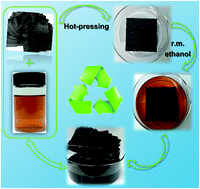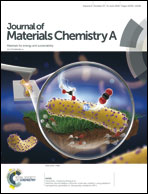Room-temperature fully recyclable carbon fibre reinforced phenolic composites through dynamic covalent boronic ester bonds†
Abstract
The cross-linked structures of traditional thermosetting resins not only endow carbon fibre-reinforced polymer (CFRP) composites with excellent performance, but also make their efficient recovery a real challenge. The goal of this paper is to create reversible thermosets using dynamic boronic ester bonds as cross-links in replacement of traditional irreversible covalent bonds. Specifically, we used phenylboronic acid (PBA) to crosslink traditional novolac resin (NR), namely PBNR. By combining the reprocessability of thermoplastics with the desirable chemical and thermal stability of conventional thermosets, controlled degradation and full recycling of cross-linked resins and CFRP composites under ambient conditions were realized through a gentle alcoholysis process. The PBNR/CFRP composites fabricated by hot-pressing showed excellent mechanical properties. The multiple recycling experiments revealed near-total recovery of the clean fibre cloth and binder materials, which could be reprocessed into composites with similar mechanical properties to fresh materials. Dynamic boronate bonds have been demonstrated to open up a new pathway for full recycling of thermosetting resins and CFRP composites, which has a great impact in aeronautical, astronautics, adhesive, coating, or electronic packaging fields.



 Please wait while we load your content...
Please wait while we load your content...